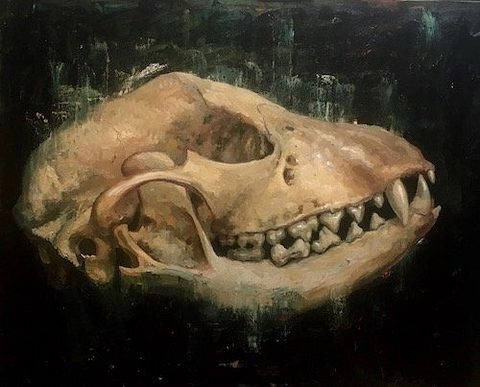
Frank Bruckmann
Skull Right.
A skull is so synonymous with death that our brains make it into a cliché, but Frank Bruckmann’s painting gets us to look through the symbol to the object itself — the shapes of the teeth, the perhaps unexpected delicacy of the animal’s cheekbone and jawbone. Bruckmann is, in short, inviting us to slow down.
It’s in keeping with the work of both Bruckmann and photographer Roy Money that appears in “Forest — Wander,” running now at Kehler Liddell Gallery in Westville through May 22. The works of both artists are evidence of their encounters with the natural places around them, even the wooded areas in their neighborhoods, and the ways those encounters can make you aware of time, both the way you use it differently in the forest than you do on a city block, and the way that time can feel more flexible (in both directions) when you trade the straight lines and sharp corners of urban places for the curving, spiraling, intertwined systems of plants, animals, and fungi.
For the works in the show, Bruckmann “explored his favorite places in Edgewood Park and the West Rock Ridge, unearthing skulls of birds, forest creatures and edible mushrooms.” His paintings fall into two categories. In one style, he places the objects in a featureless background and paints them much larger than life, “to reveal their integrity and to give them the respect that such beautiful things deserve,” as an accompanying note explains.

Frank Bruckmann
Chicken of the Woods.
In other cases, Bruckmann puts us in the woods with him, “to give the viewer the sense of walking into the magical realm of discovery that our forests and parks offer.… The viewer follows a park trail that leads to a gnarly cooper beech with complex root systems and mycelial networks crowned with seasonal fungi, or the soil of a decomposing stump which spurts forth a cluster of suedelike textured, neon orange Laetiporus sulphureus, a.k.a., chicken of the woods,” the accompanying text explains. “All these discoveries have earned my time and attention.”
In short, for Bruckmann, the woods are a place to stop running around as modern life demands, and instead make a moment to linger — to, in effect, slow time. “I’m there, stationary in the woods, knowing that people, their kids, their dogs will pass by me, the weather and the light will change, and I will come away with this tableau, this scrap of life; an experience.”

Roy Money
Elder Feet.
Where Bruckmann finds stillness and space in his moments in the woods, Roy Money finds a restless energy. Money “has not yet found a better place for my camera work than wandering in the woods. I have strayed near and far, as far as I can go, but these pictures are from a neighborhood park,” he relates in an accompanying statement. But Money’s treatment of the same subject — the root system of a large tree — draws such attention to its variegated texture that the roots seem almost to be in motion. The same is true of other highly detailed photographs, of branches, leaf structures, or other plant life.

Roy Money.
Last Look.
In another series of photographs, Money makes the idea of movement even more literal. The photos’ lack of focus is entirely intentional; it “evolved out of a chance event ten years ago, when I followed a conventional exposure of birch trees with one involving intentional camera movement. I found the result more commensurate with my experience and was astonished. In the case of these pictures, the subject matter is blurred because of the camera movement. I think of the blurred boundaries as a displacement of my animation by the subject back to the source. There is no sharp separation between us as it has occupied me. The blur expresses my acknowledgment of its capacity to move me and a bow to its presence.”
Both Bruckmann and Money find in the woods a sense of elastic time, which in turn leads to a more elastic sense of who they are in relation to the environment around them. It’s funny that two opposing cliches — that we go to the woods to lose ourselves and that we go to the woods to find ourselves — are repeated with relatively equal frequency. Both are also a little unsatisfying. Maybe that’s because, as Bruckmann’s and Money’s works suggest, we do a little bit of both at the same time.
“Forest — Wander” runs at Kehler Liddell Gallery, 873 Whalley Ave., through May 22. Visit the gallery’s website for hours and more information.